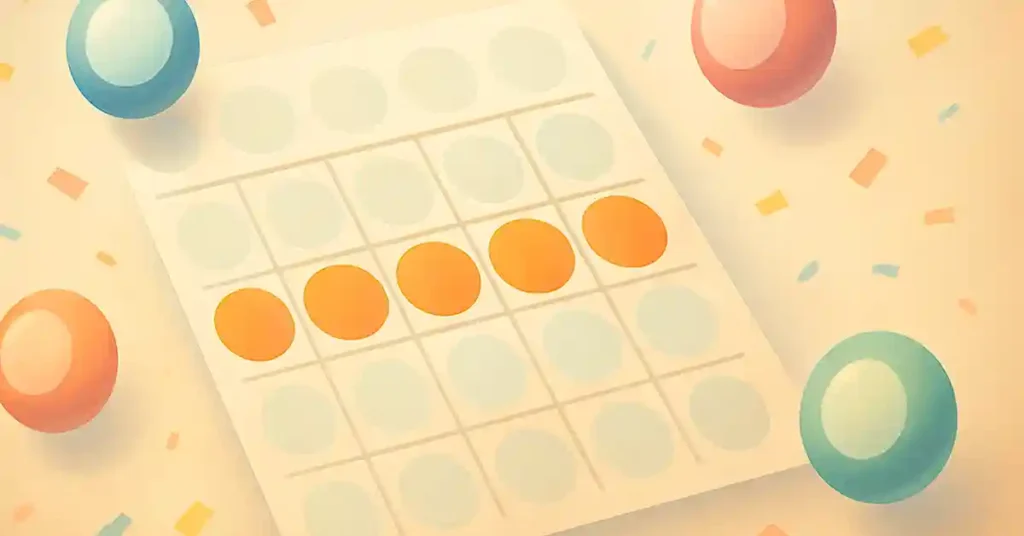Picture this: you’re at a lively community hall, dauber poised, heart racing as the caller rattles through numbers. Someone shouts “Bingo!”—but if you peek at their card, chances are the winning line runs horizontally, not vertically. That surprising reality is what mathematicians call the Bingo Paradox. When lots of people play, a row win is more than three times as likely as a column win, leaping to 73.73 percent if you’re using the classic “free” center square. Let’s unpack why this happens, why it matters, and how even a humble game night can fuel big, bright story ideas.
A Quick Refresher on Classic Bingo
Before we dive into probability, here’s a 60-second recap:
The card – a 5 × 5 grid labeled B I N G O from left to right.
Numbers – each column pulls from a specific 15-number range (B = 1-15, I = 16-30, etc.).
Win conditions – rows, columns, diagonals, four corners, and special “picture-frame” patterns in variant games.
Free space – that friendly center square many of us mark before the first call.
Simple enough—but the distribution of numbers hides a sneaky bias.
Where the “Paradox” Pops Up
Imagine 200 enthusiastic players, each clutching a unique card. Statistically, one of them will finish a row long before anyone nails a column. At first, it feels counter-intuitive: rows and columns both hold five squares, right? Yet their probability paths aren’t symmetrical. Here’s why:
Range overlap – A horizontal line samples all five 15-number ranges, so each new call can potentially help every row on every card.
Range isolation – A vertical line draws solely from one range, meaning every number in that set must show up before the card can shout victory.
Free space boost – When your center square’s already stamped, a middle row needs only four hits, while a middle column still needs five.
Mathematically, that translates to a 3-to-1 advantage for rows over columns—an edge that grows when hundreds of cards are chasing the same calls
Crunching the Odds (Without Dulling the Fun)
If you adore equations, the formal proof published in Math Horizons models each column’s 15-number “bucket” as a discrete random variable, then runs a cumulative-calls simulation until a five-in-one-bucket event versus a one-in-each-bucket event occurs. Not a stats buff? Here’s a breezy analogy:
Think of five fruit bowls. A row win is like needing one-piece of fruit from each bowl—any apple, any orange, any banana, and so on. A column win is like needing five apples before you’re allowed a single orange. When a grocer keeps tossing random fruit your way, it’s obvious which shopping list gets checked off first.
That intuition scales up beautifully with bingo balls.
Bingo Paradox in Pop Culture & Storytelling
Writers thrive on paradoxes, and this one’s riff-worthy gold:
Plot prompt #1 – The Lucky Row
A retiree swears by vertical strategies—until a statistics-loving grandchild tests the Bingo Paradox and flips the family fortune. Conflict, comedy, and probability tables ensue.Plot prompt #2 – Casino Conundrum
A rogue math prodigy designs a bingo-hall hustle exploiting horizontal odds—only to attract the wrong sort of attention when jackpots climb faster than management expects.Plot prompt #3 – Sci-Fi Twist
On a generational starship, resource allocation is decided by AI-run bingo. A glitch re-weights the ranges, tilting outcomes. Cue moral questions about randomness, fairness, and trust in machines.
Notice how a nugget of real-world math sparks endless narrative offshoots. Readers love learning something new while turning pages, and this paradox is a perfect conversation starter.
Tips for Writers: Weaving the Paradox Naturally
Show, don’t tell – Let a character scratch off a center square and smugly mutter “Horizontals are hotter,” hinting at the math without a lecture.
Heighten stakes – Whether the prize is petty cash or pivotal exposition, betting on a “low-odds” vertical line ratchets tension.
Mirror themes – Horizontal wins resonate with ideas of collaboration (across ranges), while columns symbolize specialization. Use that symbolism to echo character arcs.
Avid Readers: Spot the Paradox Easter Egg
Next time you binge a cozy mystery or binge-watch a retro TV episode featuring bingo (they pop up surprisingly often), clock which line type grants victory. Writers in the know can’t resist sneaking the real odds onto the page.
Beyond the Card: Everyday Lessons
Data over hunches – The Bingo Paradox is a cheery reminder that casual intuition falters against well-structured probabilities.
Diverse inputs win – Just as a horizontal line pulls from five ranges, creative projects thrive when you mix genres, voices, and perspectives.
Celebrate near-misses – Vertical hopefuls don’t “lose”; they illustrate the thrill of long-shot endeavors—a narrative staple from heroic epics to under-dog comedies.
Frequently Asked (and Fun) Questions
Q: Does adding crazy shapes—like an “X” pattern—change the paradox?
A: Absolutely. Special patterns have their own probability profiles, but none eclipse the horizontal row for speed in standard play.
Q: Could you design a perfectly fair card?
A: You’d need uniform number ranges in every line, effectively reinventing the game. Balance is possible, but the resulting card might look nothing like bingo as we know it.
Q: Will callers ever tweak the rules?
A: Some halls already offer progressive jackpots for column wins, acknowledging their rarity. House rules evolve—keeping a little mystery in the mix.
Final Dab of Ink
The Bingo Paradox isn’t just a math curiosity tucked in an academic journal; it’s living proof that surprises hide in plain sight—even on a card you’ve seen a thousand times. Whether you’re a writer mining fresh plot ore, a reader savoring trivia to share at your next book-club soirée, or a casual gamer eager for bragging rights, this paradox offers a dose of wonder dressed in dauber ink and numbered balls.
So, next game night, flash a knowing grin when you ink that first B…then whisper to your neighbor, “Trust me, horizontals rule.”
